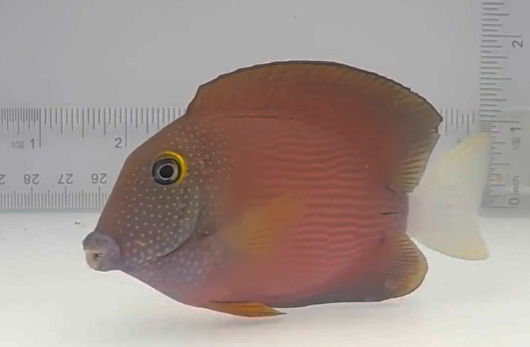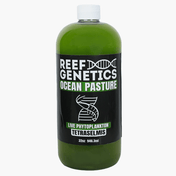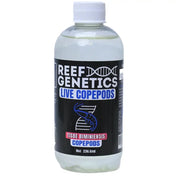The White Tail Bristletooth Tang (Ctenochaetus flavicauda) is one of the most eye‑catching members of the tang family, instantly recognizable by its deep chocolate‑brown to purple body and contrasting pure white tail. Native to the Central Pacific, this species is valued not only for its striking appearance but also for its role as an efficient algae grazer in reef aquariums.
Often referred to as the White Tail Tang or simply a Bristletooth Tang, this fish uses its specialized bristle‑like teeth to scrape film algae and detritus from rocks, glass, and other surfaces. In a well‑established reef tank, it can be an essential part of your natural cleanup crew, helping to maintain healthy water quality and keep nuisance algae in check.
While generally peaceful, the White Tail Bristletooth Tang does have its quirks. It can be territorial toward other tangs, especially those with a similar body shape or feeding niche, so thoughtful tankmate selection is important. With the right setup, diet, and care, this tang can thrive for many years, becoming a centerpiece in your reef aquarium.
Natural Habitat & Behavior
In the wild, the White Tail Bristletooth Tang (Ctenochaetus flavicauda) is most commonly found in the Central Pacific, particularly around the Marshall Islands and nearby reef systems. They inhabit outer reef slopes, rubble zones, and areas rich in algae growth, where they can graze throughout the day. These zones typically have strong water movement, excellent oxygenation, and abundant hard surfaces for algae to grow.
Bristletooth Tangs are diurnal grazers, meaning they are most active during the day, constantly foraging for food. Their specialized, comb‑like teeth are designed to scrape film algae, diatoms, and detritus from rocks and coral skeletons without damaging the reef structure. This makes them incredibly efficient algae controllers in a home aquarium.
In nature, they often travel alone or in loose groups, occasionally joining mixed‑species foraging parties. While they are generally peaceful toward other reef inhabitants, they can show territorial behavior toward other tangs, especially those with a similar shape or feeding style. This natural instinct to protect their grazing territory is the main reason tank size and aquascape design are so important in captivity.
By understanding their natural environment and behavior, reef keepers can better recreate the conditions that keep White Tail Bristletooth Tangs healthy, active, and stress‑free in a home aquarium.
Appearance & Distinguishing Features
The White Tail Bristletooth Tang is instantly recognizable thanks to its rich chocolate‑brown to deep violet adult body paired with a bright, snow‑white tail fin. This striking contrast makes it a standout in reef aquariums, and under reef lighting, subtle blue and purple iridescence can often be seen shimmering along its flanks.
Juveniles, however, look quite different. Young White Tail Bristletooth Tangs often have a yellowish to golden‑brown body, with the white tail less prominent or faint. As they mature, their body gradually darkens to the characteristic deep brown or purple, and the tail brightens to a crisp, pure white. This transition can happen over several months and is a natural sign of healthy growth.
True to its name, this species belongs to the Bristletooth Tang group (Ctenochaetus genus). Instead of the flat, chisel‑like teeth found in many tang species, they have rows of fine, comb‑like teeth designed to scrape film algae, diatoms, and detritus from hard surfaces without damaging the reef structure.
Adults typically reach 5 to 6 inches in captivity, with a streamlined body built for constant foraging and quick bursts of movement. Like all tangs, they possess a sharp caudal spine at the base of the tail — a natural defensive tool when threatened. Healthy individuals display consistent coloration, active grazing behavior, and a full, rounded body profile.
Ideal Tank Setup for the White Tail Bristletooth Tang
The White Tail Bristletooth Tang (Ctenochaetus flavicauda) is an active, constantly grazing fish that thrives in a tank large enough to provide both ample swimming space and plenty of grazing opportunities. A minimum tank size of 75 gallons is recommended for a single adult, though larger systems offer more stability and swimming room, especially if other tangs or similarly active fish will be housed together.
Aquascaping
Create a layout that balances open water for swimming with rock structures for grazing. Live rock not only provides natural algae growth for feeding but also offers shelter and resting spots. Avoid packing the rockwork too tightly — leaving open channels will allow the tang to cruise freely and explore.
Water Parameters
The White Tail Bristletooth Tang does best in stable, reef‑quality water conditions:
-
Temperature: 74–78°F
-
Salinity: 1.024–1.026 specific gravity
-
pH: 8.1–8.4
-
Ammonia & Nitrite: 0 ppm
-
Nitrate: < 20 ppm (lower preferred for reef systems)
Filtration & Flow
Because they are constant grazers and contribute a fair amount of waste, strong biological filtration is essential. A quality protein skimmer and good water movement will help maintain water quality and oxygenation. Flow should be moderate to strong, mimicking the currents found on natural reef slopes.
Lighting
While the fish itself doesn’t require special lighting, standard reef‑appropriate lighting will encourage healthy algae growth on rocks — a natural food source. Too little light can reduce grazing opportunities, while too much can lead to nuisance algae outbreaks, so strike a balance.
Providing the right environment will not only keep your White Tail Bristletooth Tang healthy but will also help it display its best coloration and natural behavior.
Diet & Feeding the White Tail Bristletooth Tang
In the wild, the White Tail Bristletooth Tang (Ctenochaetus flavicauda) spends most of its day grazing on microalgae and diatoms that grow on rocks and other hard surfaces. Its specialized bristle‑like teeth are designed to scrape algae film without damaging the reef structure. This constant grazing behavior is essential for its health and should be encouraged in captivity.
Primary Diet
The bulk of this tang’s diet should come from algae and plant‑based foods. In a mature reef aquarium with live rock, they will naturally pick at microalgae between feedings, helping to keep nuisance algae under control. However, supplemental feeding is still needed to maintain optimal nutrition.
Recommended Foods
-
Dried seaweed (nori) — Clip a sheet to the glass daily for grazing.
-
Spirulina‑based pellets or flakes — Provide balanced plant protein.
-
Frozen herbivore blends — Contain a mix of marine algae and vegetables.
-
Occasional fresh macroalgae — Such as gracilaria or ogo, if available.
Feeding Frequency
Feed small portions 2–3 times per day to mimic their natural grazing pattern. Avoid overfeeding meaty or high‑protein foods — while they may nibble on these occasionally, too much can lead to digestive issues and poor long‑term health.
Nutritional Variety
For vibrant coloration, strong immunity, and sustained energy, rotate between different algae sources and herbivore‑specific foods. Soaking dry foods in vitamin supplements like Selcon can further help prevent deficiencies.
Maintaining a nutrient‑rich, algae‑focused diet is one of the most important steps in keeping your White Tail Bristletooth Tang healthy, active, and thriving for years.
Temperament & Compatibility
The White Tail Bristletooth Tang is generally considered one of the more peaceful tang species, especially compared to some of the larger, more aggressive surgeonfish. They typically get along well with a wide variety of reef‑safe fish, invertebrates, and corals, making them an excellent choice for mixed reef tanks.
That said, like all tangs, they can be territorial toward their own kind or other tangs with a similar body shape and feeding style. This is especially true in smaller tanks or if two algae‑grazing tangs are introduced at the same time. In most cases, the White Tail Tang will be peaceful toward dissimilar fish species, but cautious introduction is always best.
Best Tankmates
-
Peaceful to moderately active reef‑safe fish such as wrasses, gobies, anthias, and chromis
-
Reef‑safe dwarf and large angelfish
-
Other tang species with different body shapes (introduced carefully)
-
Reef‑safe invertebrates such as cleaner shrimp, snails, and hermit crabs
Tankmates to Avoid or Introduce With Caution
-
Other Bristletooth Tangs (Ctenochaetus species) unless the tank is very large
-
Aggressive tangs (such as some Acanthurus or Zebrasoma species)
-
Large predatory fish that may harass or outcompete them for food
Reducing Aggression
-
Introduce the White Tail Bristletooth Tang later in the stocking order so it doesn’t immediately claim the tank as its territory
-
Provide ample rockwork and grazing areas to reduce competition for resources
-
If keeping multiple tangs, add them simultaneously or rearrange rockwork before introducing new individuals
When given enough space and the right tankmates, the White Tail Bristletooth Tang will thrive as an active, peaceful member of the reef, constantly on the move and grazing — exactly as it would in the wild.
Care Challenges & Common Health Concerns
While the White Tail Bristletooth Tang is hardy once established, there are a few challenges reef keepers should be aware of to ensure long‑term success.
1. Susceptibility to Marine Ich & Other Parasites
Like all tangs, this species is prone to Cryptocaryon irritans (marine ich) and other external parasites. Their constant swimming and thin protective slime coat make them more vulnerable than some other fish. A proper quarantine period before introduction is highly recommended to prevent introducing parasites to your display tank.
2. Nutritional Deficiencies
Because they are specialized algae grazers, an improper diet can quickly lead to deficiencies.
-
Lateral Line Erosion (HLLE): Often linked to poor nutrition or water quality.
-
Color Fading: Lack of varied algae sources and vitamins can cause muted coloration.
To prevent these issues, feed a varied, algae‑rich diet and consider vitamin supplementation.
3. Territorial Aggression
While generally peaceful, they can become aggressive toward other tangs, especially those in the Ctenochaetus genus. This is often more pronounced in smaller tanks or if they are introduced before other tangs.
4. Stress from Poor Acclimation or Tank Conditions
White Tail Bristletooth Tangs are active swimmers that rely on stable, high‑quality water. Rapid parameter swings, poor oxygenation, or cramped swimming space can cause long‑term stress, making them more prone to disease.
Pro Tip: Maintain excellent water quality, provide plenty of grazing space, and ensure they receive a proper quarantine and diet from day one. Addressing these challenges early greatly improves their odds of thriving for many years.
Coloration & Growth in Captivity
One of the most fascinating aspects of the White Tail Bristletooth Tang is its dramatic color transformation as it matures.
Juvenile Coloration
Young fish often display a yellowish to golden‑brown body, with a less distinct or faint white tail. This stage is short‑lived but highly distinctive — and it’s one of the easiest ways to identify juveniles in the trade.
Adult Coloration
As they grow, the yellow hue gradually fades, replaced by a rich chocolate‑brown to deep violet body accented by a brilliant, snow‑white tail. Under reef lighting, adults often exhibit subtle blue and purple iridescence along their flanks.
Factors That Influence Coloration
-
Diet: A nutrient‑rich, algae‑based diet supports vibrant colors and healthy tissue.
-
Lighting: Balanced reef lighting can enhance subtle purple and blue tones.
-
Water Quality: Stable, pristine water conditions help prevent color fading.
-
Overall Health: Stress from poor tank conditions, aggression, or malnutrition can dull coloration.
Growth in Captivity
In a healthy environment, the White Tail Tang typically reaches 5–6 inches in length in captivity, though growth rate can vary. Juveniles tend to grow faster during their first year, especially with consistent feeding and excellent water quality.
Providing a proper diet and a stress‑free environment will not only keep your tang healthy but will also help it maintain its striking contrast and natural vibrancy over the years.
Conclusion & Care Summary
The White Tail Bristletooth Tang (Ctenochaetus flavicauda) is a stunning and highly functional addition to a reef aquarium. Its constant grazing helps manage nuisance algae, while its rich brown‑purple body and crisp white tail bring a striking visual contrast to the tank.
Though generally peaceful, this tang still needs ample swimming space and careful compatibility planning, especially if housed with other tangs. A mature reef tank with plenty of live rock will provide both the grazing opportunities and the stability it needs to thrive.
Success with this species comes down to a few key points:
-
Tank Size: 75+ gallons with open swimming areas and rock for grazing.
-
Diet: Primarily algae‑based, supplemented with nori, spirulina, and herbivore blends.
-
Water Quality: Stable reef parameters with strong filtration and good oxygenation.
-
Compatibility: Generally peaceful, but can be territorial with similar tangs.
-
Health Management: Quarantine before adding, watch for signs of ich, and maintain varied nutrition to prevent deficiencies.
For aquarists willing to meet its needs, the White Tail Bristletooth Tang rewards you with active, graceful swimming, a helpful grazing habit, and a bold splash of contrast in your reef display — making it a true standout among surgeonfish.



















